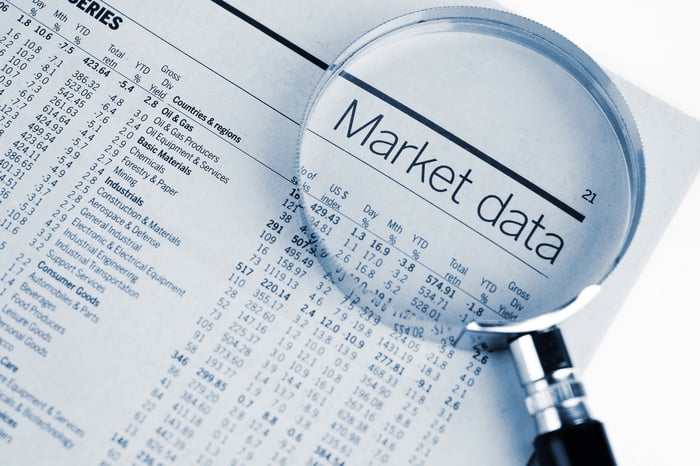Are Stocks Finally Cheap Again? Here's Why Investors Can't Trust This Popular Valuation Metric Right Now.
-
The S&P 500 fell nearly 20% before a pause on tariffs lifted the market above its lows.
-
The next few weeks will show whether stocks are actually cheap.
-
Investors don't need to wait around before buying stocks, but they should pay attention to this one thing.
The stock market experienced an incredible bull run for over two years, starting in October of 2022. Expectations for lower interest rates combined with massive advancements in artificial intelligence created an incredible environment for growth. Stocks continued to soar higher through the start of 2025, reaching valuation levels rarely seen in stock-market history.
But stocks started to tumble in mid-February. And following President Donald Trump's tariff announcement on April 2, they crashed, giving up all the gains of the previous year. The tech-heavy Nasdaq Composite index fell into bear market territory, as did the small-cap Russell 2000 index. The S&P 500 (^GSPC 0.79%) came close, but narrowly staved off the requisite 20% drop from its all-time high before recovering slightly.
Still, stocks remain significantly below the highs reached in February, so you may be wondering if it's time to start buying at these lower valuations. But it's important to note that the most popular valuation metric for stocks isn't totally reliable right now. Here's what you need to know.

Image source: Getty Images.
How cheap are stocks right now?
One of the most common measures of stock-market valuation is the forward price-to-earnings (P/E) ratio of the S&P 500. This ratio takes the expected earnings based on analysts' estimates for each company in the S&P 500 over the next 12 months, and weights each by the relative market cap of each company in the index. The index value divided by those expected earnings equals the index's forward P/E.
As of this writing (April 11), the S&P 500's forward P/E sits at around 18.2. That's a stark decline from the ratio of 22 that the index had at the end of 2024 and early 2025. It also sits below the five-year average valuation for the index.
So you might think stocks look relatively inexpensive, making it a great time to buy. As fears rise amid growing trade tensions between the world's two biggest economies, perhaps it's time to get greedy, as Warren Buffett would say. But stocks might not be as cheap as they look. Here's why.
The market moves in anticipation of the news
The reason investors prefer to look at the forward price-to-earnings ratio compared to the trailing P/E is because stock prices aren't based on what's already happened: They're based on what investors expect will happen in the future. And often stock prices are a better reflection of expectations than any analyst notes or forecasts available.
Money talks, and it talks fast.
Analysts aren't updating their earnings expectations or price targets every day, let alone every month. They usually wait for a significant event to trigger a reevaluation of their financial models, and then take the time to write out their thoughts for investors. While we saw a major event earlier this month, there are still some big events to come over the next five weeks or so -- namely, many companies' first-quarter earnings reports.
The combination of tariffs, Q1 earnings results, and management commentary about how the current economy will impact their businesses could lead to a massive revision in earnings expectations.
JPMorgan Chase CEO Jamie Dimon said he expects many companies to remove their earnings guidance this quarter, and that analysts will slash their earnings expectations. He thinks the average estimate could go from 5% average earnings growth for the S&P 500 to a 5% decline in earnings.
If you expect analysts to cut their earnings estimates by nearly 10%, as Dimon suggests they could, the current forward P/E of 18.2 could become a forward P/E above 20. That's not quite as cheap anymore.
What should investors be doing?
While stocks might not be as cheap as they look, that doesn't mean you should continue waiting on the sidelines for prices to keep moving lower. The market is unpredictable, and waiting around for a further decline is a losing game.
But in times of uncertainty like now, many investors need a greater margin of safety on their investments than they did in a more stable market. A margin of safety is based on your best estimate for the intrinsic value of a stock. If you're reasonably certain of its value, you don't need it to trade very far below that value to have a good chance of making money on the investment. But as uncertainty rises, you'd need a bigger discount to intrinsic value to have the confidence to put your money into the market.
The stock-market sell-off is offering a lot of big discounts relative to intrinsic value for many companies. That's especially true if you're a long-term investor who expects to hold the shares you're buying well beyond the current U.S. presidential administration. If you find stocks trading with a big enough margin of safety, you can confidently buy them today.
Disclaimer: Investing carries risk. This is not financial advice. The above content should not be regarded as an offer, recommendation, or solicitation on acquiring or disposing of any financial products, any associated discussions, comments, or posts by author or other users should not be considered as such either. It is solely for general information purpose only, which does not consider your own investment objectives, financial situations or needs. TTM assumes no responsibility or warranty for the accuracy and completeness of the information, investors should do their own research and may seek professional advice before investing.
Most Discussed
- 1
- 2
- 3
- 4
- 5
- 6
- 7
- 8
- 9
- 10